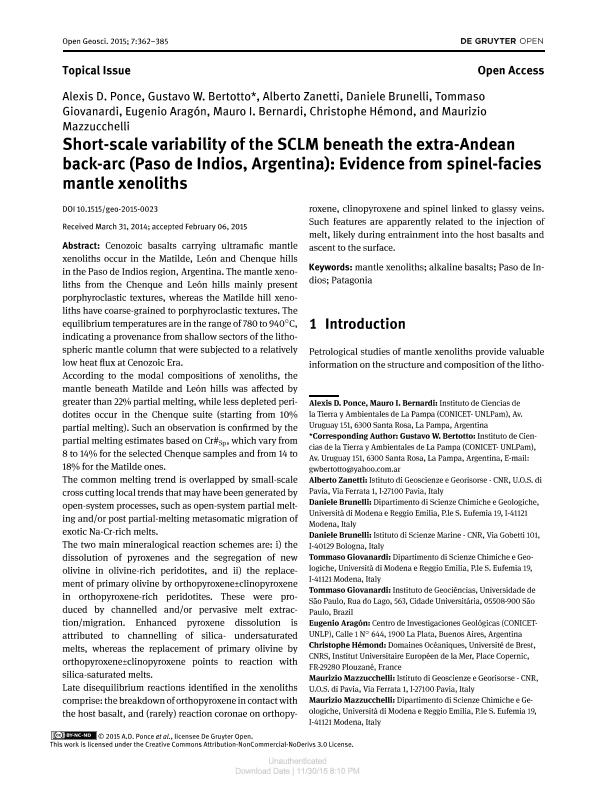Mostrar el registro sencillo del ítem
dc.contributor.author
Ponce, Alexis Daniel

dc.contributor.author
Bertotto, Gustavo Walter

dc.contributor.author
Zanetti, Alberto
dc.contributor.author
Brunelli, Daniele
dc.contributor.author
Giovanardi, Tommaso
dc.contributor.author
Aragon, Eugenio

dc.contributor.author
Bernardi, Mauro Ignacio

dc.contributor.author
Hémond, Christophe
dc.contributor.author
Mazzucchelli, Maurizio

dc.date.available
2022-03-03T04:09:28Z
dc.date.issued
2015-02
dc.identifier.citation
Ponce, Alexis Daniel; Bertotto, Gustavo Walter; Zanetti, Alberto; Brunelli, Daniele; Giovanardi, Tommaso; et al.; Short-scale variability of the SCLM beneath the extra-Andean back-arc (Paso de Indios, Argentina): Evidence from spinel-facies mantle xenoliths; De Gruyter; Open Geosciences; 7; 1; 2-2015; 362-385
dc.identifier.uri
http://hdl.handle.net/11336/152797
dc.description.abstract
Cenozoic basalts carrying ultramafic mantle xenoliths occur in the Matilde, León and Chenque hills in the Paso de Indios region, Argentina. The mantle xenoliths from the Chenque and León hills mainly present porphyroclastic textures, whereas the Matilde hill xenoliths have coarse-grained to porphyroclastic textures. The equilibrium temperatures are in the range of 780 to 940°C, indicating a provenance from shallow sectors of the lithospheric mantle column that were subjected to a relatively low heat ffiux at Cenozoic Era. According to the modal compositions of xenoliths, the mantle beneath Matilde and León hills was affected by greater than 22% partial melting, while less depleted peridotites occur in the Chenque suite (starting from 10% partial melting). Such an observation is confirmed by the partial melting estimates based on Cr# Sp , which vary from 8 to 14% for the selected Chenque samples and from 14 to 18% for the Matilde ones. The common melting trend is overlapped by small-scale cross cutting local trends that may have been generated by open-system processes, such as open-system partial melting and/or post partial-melting metasomatic migration of exotic Na-Cr-rich melts. The two main mineralogical reaction schemes are: i) the dissolution of pyroxenes and the segregation of new olivine in olivine-rich peridotites, and ii) the replacement of primary olivine by orthopyroxene±clinopyroxene in orthopyroxene-rich peridotites. These were produced by channelled and/or pervasive melt extraction/migration. Enhanced pyroxene dissolution is attributed to channelling of silica-undersaturated melts, whereas the replacement of primary olivine by orthopyroxene±clinopyroxene points to reaction with silica-saturated melts. Late disequilibrium reactions identified in the xenoliths comprise: the breakdown of orthopyroxene in contact with the host basalt, and (rarely) reaction coronae on orthopyroxene, clinopyroxene and spinel linked to glassy veins. Such features are apparently related to the injection of melt, likely during entrainment into the host basalts and ascent to the surface.
dc.format
application/pdf
dc.language.iso
eng
dc.publisher
De Gruyter

dc.rights
info:eu-repo/semantics/openAccess
dc.rights.uri
https://creativecommons.org/licenses/by-nc-nd/2.5/ar/
dc.subject
XENOLITH
dc.subject
MANTLE
dc.subject
SPINEL
dc.subject
PATAGONIA
dc.subject.classification
Geoquímica y Geofísica

dc.subject.classification
Ciencias de la Tierra y relacionadas con el Medio Ambiente

dc.subject.classification
CIENCIAS NATURALES Y EXACTAS

dc.title
Short-scale variability of the SCLM beneath the extra-Andean back-arc (Paso de Indios, Argentina): Evidence from spinel-facies mantle xenoliths
dc.type
info:eu-repo/semantics/article
dc.type
info:ar-repo/semantics/artículo
dc.type
info:eu-repo/semantics/publishedVersion
dc.date.updated
2022-03-02T15:52:29Z
dc.identifier.eissn
2391-5447
dc.journal.volume
7
dc.journal.number
1
dc.journal.pagination
362-385
dc.journal.pais
Polonia

dc.journal.ciudad
Varsovia
dc.description.fil
Fil: Ponce, Alexis Daniel. Consejo Nacional de Investigaciones Científicas y Técnicas. Instituto de Ciencias de la Tierra y Ambientales de La Pampa. Universidad Nacional de La Pampa. Facultad de Ciencias Exactas y Naturales. Instituto de Ciencias de la Tierra y Ambientales de La Pampa; Argentina
dc.description.fil
Fil: Bertotto, Gustavo Walter. Consejo Nacional de Investigaciones Científicas y Técnicas. Instituto de Ciencias de la Tierra y Ambientales de La Pampa. Universidad Nacional de La Pampa. Facultad de Ciencias Exactas y Naturales. Instituto de Ciencias de la Tierra y Ambientales de La Pampa; Argentina
dc.description.fil
Fil: Zanetti, Alberto. Istituto di Geoscienze e Georisorse; Italia
dc.description.fil
Fil: Brunelli, Daniele. Università di Modena e Reggio Emilia; Italia
dc.description.fil
Fil: Giovanardi, Tommaso. Università di Modena e Reggio Emilia; Italia. Universidade de Sao Paulo; Brasil
dc.description.fil
Fil: Aragon, Eugenio. Consejo Nacional de Investigaciones Científicas y Técnicas. Centro Científico Tecnológico Conicet - La Plata. Centro de Investigaciones Geológicas. Universidad Nacional de La Plata. Facultad de Ciencias Naturales y Museo. Centro de Investigaciones Geológicas; Argentina
dc.description.fil
Fil: Bernardi, Mauro Ignacio. Consejo Nacional de Investigaciones Científicas y Técnicas. Instituto de Ciencias de la Tierra y Ambientales de La Pampa. Universidad Nacional de La Pampa. Facultad de Ciencias Exactas y Naturales. Instituto de Ciencias de la Tierra y Ambientales de La Pampa; Argentina
dc.description.fil
Fil: Hémond, Christophe. Universite de Bretagne Occidentale; Francia
dc.description.fil
Fil: Mazzucchelli, Maurizio. Università di Modena e Reggio Emilia; Italia
dc.journal.title
Open Geosciences
dc.relation.alternativeid
info:eu-repo/semantics/altIdentifier/url/http://www.degruyter.com/view/j/geo.2015.7.issue-1/geo-2015-0023/geo-2015-0023.xml?format=INT
dc.relation.alternativeid
info:eu-repo/semantics/altIdentifier/doi/http://dx.doi.org/10.1515/geo-2015-0023
Archivos asociados
